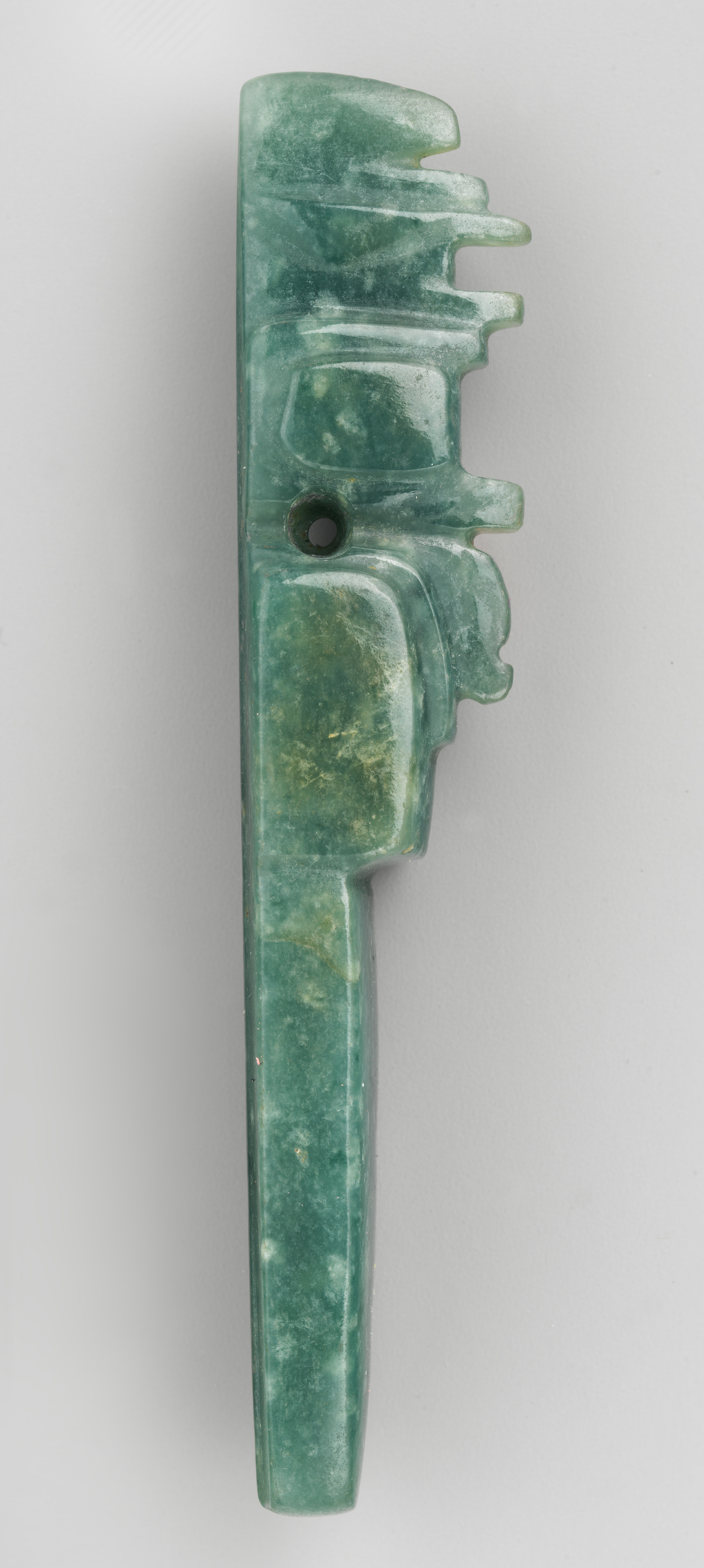Celt pendant
Greater Nicoya or Central region artitst(s)
Para español, véase abajo.
Greenstone pendants were manufactured from a variety of raw materials in the Central and the Greater Nicoya regions of Costa Rica starting as early as 500 BCE, until around 800 CE. Although some of those materials were locally available, the nearest known source specifically of jadeite is in the region of the Motagua River in Guatemala. Therefore, the use of jadeite in ancient Costa Rica reveals long-distance connections across Central America. The appearance of this distinctive style of pendant, made from imported materials, during a period of incipient social inequalities, suggests that they were a sign of prestige and differentiation.
This singular pendant combines anthropomorphic and zoomorphic features commonly found in other examples from the region, in a particularly stylized way. The frontal view shows a human figure with the arms folded, wearing a tall headdress that resembles a bird’s crest. The profile view, on the other hand, reveals a strikingly different, abstract figure consisting of a series of horizontal spikes and blocks.
The manufacture of such a small, yet elongated pendant is a multistage process that begins with a complete axe, which is progressively divided into symmetrical parts. The clean lines and intricate details in this pendant demonstrate the artist’s mastery of jade working techniques.
Amanda Suárez Calderón, 2025
Further Reading
Hoopes, John. “Magical Substances in the Land between the Seas.” In Golden Kingdoms. Luxury Arts in the Ancient Americas, edited by Joanne Pillsbury, Timothy Potts, and Kim N. Richter. Los Angeles: The J. Paul Getty Museum and The Getty Research Institute, 2017.
Kuboyama-Haraikawa, Waka. Celtiform Pendants from Pre-Columbian Costa Rica. Oxford, UK: BAR Publishing, 2023.
McEwan, Colin, and John Hoopes, eds. Pre-Columbian Art from Central America and Colombia at Dumbarton Oaks. Washington, DC: Dumbarton Oaks Research Library and Collection, 2021.
Los artesanos de las regiones Central y Gran Nicoya de Costa Rica fabricaron pendientes de una variedad de piedras verdes, llamadas genéricamente jade, aproximadamente desde el 500 AEC hasta el 800 EC. Aunque hay fuentes locales de algunas de estas piedras, la fuente más cercana conocida hasta ahora específicamente de jadeíta se encuentra en la región del Río Motagua en Guatemala. Por lo tanto, el uso de esta piedra en la antigua Costa Rica demuestra la existencia de conexiones a larga distancia a través de Centro América. La aparición de estos pendientes con su estilo distintivo durante un periodo de surgimiento de desigualdades sociales sugiere que eran símbolos de prestigio y diferenciación.
Este singular pendiente combina rasgos antropomorfos y zoomorfos comunes en otros ejemplares de la región, de una manera particularmente estilizada. La vista de frente muestra una figura humana con los brazos cruzados, luciendo un tocado alto que se asemeja a una cresta de pájaro. La vista lateral, por otro lado, revela una figura sorprendentemente diferente y abstracta, compuesta de una serie de bloques y puntas horizontales.
La fabricación de un pendiente tan pequeño, y a la vez alargado, es un proceso de múltiples etapas que comienza con un hacha completa, la cual se va dividiendo progresivamente en partes simétricas. Las líneas limpias y los detalles intricados de este pendiente demuestran la maestría del artista en las técnicas de trabajo en jade.
Amanda Suárez Calderón, 2025
Lecturas adicionales
Hoopes, John. “Magical Substances in the Land between the Seas.” In Golden Kingdoms. Luxury Arts in the Ancient Americas, edited by Joanne Pillsbury, Timothy Potts, and Kim N. Richter. Los Angeles: The J. Paul Getty Museum and The Getty Research Institute, 2017.
Kuboyama-Haraikawa, Waka. Celtiform Pendants from Pre-Columbian Costa Rica. Oxford, UK: BAR Publishing, 2023.
McEwan, Colin, and John Hoopes, eds. Pre-Columbian Art from Central America and Colombia at Dumbarton Oaks. Washington, DC: Dumbarton Oaks Research Library and Collection, 2021.
This image cannot be enlarged, viewed at full screen, or downloaded.
This artwork is meant to be viewed from right to left. Scroll left to view more.



